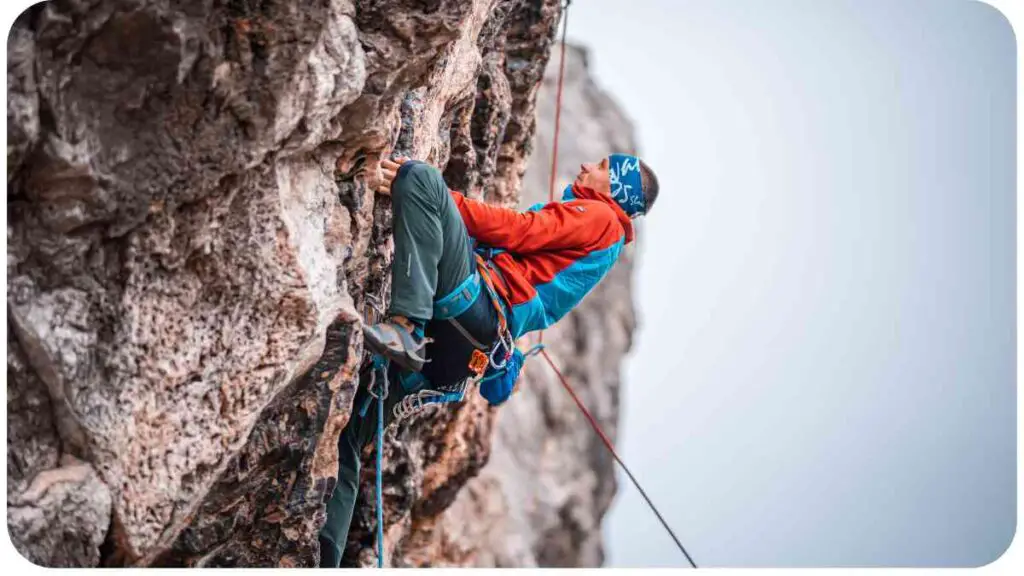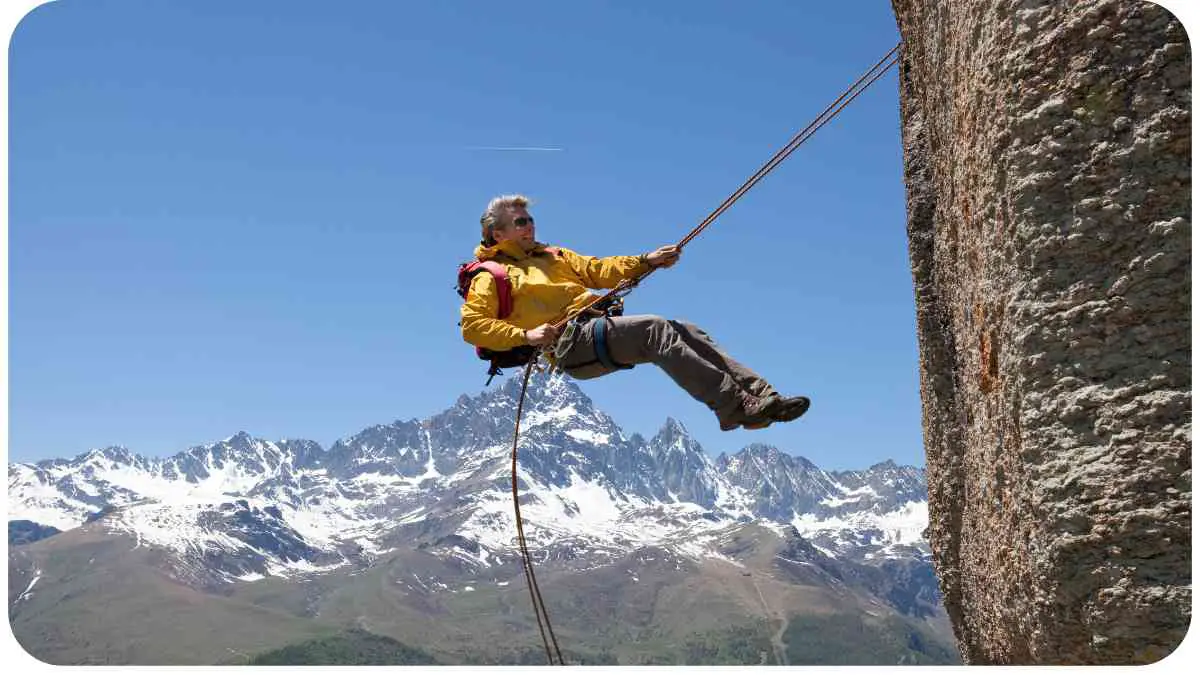Rappelling, also known as abseiling, is an exhilarating vertical activity that allows you to descend steep cliffs, canyons, and rock walls using ropes and specialized equipment. Whether you’re a beginner or an experienced climber, it’s important to be familiar with common rappelling concerns to ensure a safe and enjoyable descent.
In this guide, we will address various troubleshooting techniques and provide valuable insights to help you overcome any obstacles you may encounter during your rappelling adventures.
| Takeaways |
|---|
| Proper equipment check is essential for a safe descent |
| Understanding knots and anchors is crucial for control and safety |
| Effective rope management prevents tangles and complications |
| Employing proper techniques ensures a smooth descent |
| Avoid common mistakes like lack of communication and inadequate anchoring |
| Troubleshoot issues like rope jam, rope twist, and slow descent |
| Regular gear maintenance and inspection enhance safety |
2. Equipment Check
Before embarking on any rappelling adventure, it’s crucial to perform a thorough equipment check. Your safety relies on the functionality and reliability of your gear. Here’s a table summarizing the essential rappelling equipment and their associated characteristics:
When it comes to descending safely, it’s crucial to master belay device troubleshooting. Understanding and resolving common issues ensures a secure and controlled descent for a worry-free climbing experience.
| Equipment | Characteristics |
| Harness | Proper fit, secure buckles, no damage |
| Helmet | Snug fit, no cracks or dents |
| Ropes | No visible wear, proper length |
| Carabiners | Working gate, no signs of damage |
| Belay Device | Smooth operation, no excessive wear |
| Gloves | Good grip, no tears or holes |
Double-checking your equipment prior to each rappelling session ensures that you’re fully equipped and ready to tackle any obstacles that may arise.
3. Knots and Anchors
Proper knowledge of knots and anchors is essential for a safe rappelling experience. The table below displays some commonly used knots and their applications:
| Knot | Application |
| Figure Eight | Main rappelling knot |
| Double Fisherman | Joining ropes together or creating Prusik loops |
| Clove Hitch | Securing the rope to an anchor or a carabiner |
| Munter Hitch | Acting as a belay device in emergency situations |
Understanding how and when to use these knots is vital for maintaining control and safety during your descent.
For climbers seeking high-altitude adventures, recognizing and addressing altitude sickness is paramount. Explore the causes, symptoms, and effective remedies to ensure a safe and enjoyable ascent.
4. Rope Management

Proper rope management is crucial to ensure a smooth rappelling experience. Here are a few tips to keep in mind:
- Coiling: Coiling your rope properly helps eliminate tangles and prevents rope twists. Always coil the rope using a butterfly coil or a similar technique to avoid kinks.
- Rope Protection: Utilize rope protectors like rope bags or tarps to prevent damage caused by sharp edges, abrasive surfaces, or rough terrain.
- Rope Inspection: Regularly inspect your rope for signs of wear, fraying, or abrasion. Replace it if you notice any damage that compromises its strength or integrity.
- Dress the Anchor: Ensure the anchor is properly dressed, which means the rope is aligned and running parallel without crossing itself. A well-dressed anchor reduces rope drag and enhances rappelling efficiency.
Follow these rope management techniques to maintain the longevity and reliability of your ropes.
5. Techniques for a Smooth Descent
Achieving a smooth descent requires employing proper rappelling techniques. Here are a few key considerations:
- Body Position: Maintain a relaxed posture with your feet shoulder-width apart and slightly bent. Your weight should primarily be on your legs to minimize strain on your arms.
- Controlled Speed: Control your descent speed by adjusting friction on the rope using your rappelling device while maintaining a firm grip.
- Look Ahead: Keep your gaze focused on the descent rather than looking down. This helps maintain balance and situational awareness throughout the rappel.
- Backup Systems: Utilize backup systems like a prusik hitch to increase safety, especially during longer rappels.
By implementing these techniques, you’ll enhance your overall rappelling experience and minimize the risk of encountering common issues.
Maintaining a secure grip is fundamental in bouldering. Discover practical tips to prevent grip slipping during bouldering, enhancing your hold and elevating your bouldering performance to new heights.
6. Common Mistakes to Avoid

Even experienced rappellers can make mistakes that compromise safety. Let’s examine some common mistakes to avoid:
- Lack of Communication: Failing to communicate clearly between the rappeller and belayer can lead to miscommunication and potential accidents. Establish clear signals and instructions prior to rappelling.
- Inadequate Anchoring: Neglecting to adequately anchor your rope can result in anchor failure or the rope pulling loose. Ensure anchors are secure and solidly placed before rappelling.
- Insufficient Friction: Using too little friction on your rappelling device can lead to an uncontrollable descent. Adjust the friction according to the conditions and your comfort level.
- Improper Rope Retrieval: Incorrectly managing rope retrieval can cause tangles, knots, or snags. Take your time to neatly coil or pack the rope to avoid complications during your next descent.
By being mindful of these common mistakes, you can mitigate potential risks and ensure a safe and enjoyable rappelling experience.
7. Troubleshooting Common Rappelling Concerns
While rappelling, you may encounter various issues that require troubleshooting. Here are some common concerns and suggested solutions:
Safety is non-negotiable in climbing. Learn how to address a crack in your climbing helmet promptly. Ensure your gear’s integrity, prioritizing both comfort and protection on every climb.
7.1 Rope Jam
If you experience a rope jam during your descent, you can try the following steps:
- Stop Descending: Immediately stop your descent once you notice the rope jam.
- Check for Obstructions: Inspect the rope for any obstructions such as knots or twists. Gently untangle or loosen the jammed section if possible.
- Change Friction and Direction: Alter the angle of the rope or adjust the friction on your device to alleviate the jam.
- Assess the Situation: If the jam persists or seems unresolvable, consider ascending back up to the point of the jam or initiating an emergency rescue procedure.
7.2 Rope Twist
To handle a rope twist, follow these steps:
- Stop and Check: As soon as you notice the rope twisting, stop your descent and assess the situation.
- Untwist the Rope: Hold onto the rope below the twist and allow it to spin freely until the twist untwists itself. You can guide the rope slightly to aid in the untwisting process.
- Continue Descending: Once the twist is untangled, resume your descent with caution, ensuring that the rope remains untwisted.
For lead climbers, addressing common lead climbing concerns is essential for a secure and enjoyable climb. Explore practical solutions to overcome challenges, ensuring a smooth ascent to new heights.
7.3 Rope Burn
If you experience rope burn, take these measures:
- Stop Descending: Immediately stop your descent if you notice rope burn on your hands or other body parts.
- Assess the Situation: Evaluate the severity of the rope burn. If it’s minor, you can continue after taking necessary precautions. However, for more severe burns, consider seeking medical attention.
- Use Gloves: Wear gloves to protect your hands from further rope burn and improve your grip on the rope. High-quality gloves with reinforced palms offer excellent protection.
7.4 Slow Descent
If your descent is slower than expected, these steps can help:
- Check Friction: Ensure there is enough friction on the rappelling device to control your descent speed. Adjust the position or angle of the device if needed.
- Evaluate Rope Pull: Confirm that the rope is pulling smoothly through the device. If it encounters resistance, carefully examine for twists, knots, or other obstructions.
- Assess Weight Distribution: Evaluate your weight distribution and body position. Shift your weight slightly forward to increase descent speed if necessary.
7.5 Stuck Midway
If you find yourself stuck midway during a descent, take the following measures:
- Assess the Situation: Determine the reason you’re stuck, such as an anchor point, a rope entanglement, or lack of friction.
- Call for Assistance: Communicate with your belayer if you’re unable to rectify the situation on your own. Request guidance or assistance to safely continue or retrieve yourself.
- Consider Retreating: If the issue cannot be resolved or you’re uncomfortable proceeding, consider ascending back up or initiating a rescue procedure.
Remember, staying calm and composed is crucial during any troubleshooting situation while rappelling.
8. Gear Maintenance and Inspection
Maintaining and inspecting your rappelling gear regularly is essential for safety. Here’s a table highlighting recommended intervals for gear inspection:
| Gear | Inspection Frequency |
| Harness | Before every usage |
| Helmet | Before every usage |
| Ropes | Before every usage, annually |
| Carabiners | Before every usage, annually |
| Belay Device | Before every usage, annually |
| Gloves | Before every usage, as needed |
Adhering to a strict maintenance schedule ensures that your gear remains reliable, extending its lifespan and maximizing your safety.
9. Conclusion
Rappelling is an exciting adventure activity that requires proper preparation, knowledge, and gear. By understanding the troubleshooting techniques discussed in this article, you can overcome common rappelling concerns and ensure a safe descent.
Further Reading
For more information on rappelling and troubleshooting, consider checking out the following resources:
- How to Avoid Rappelling Problems on Sportrock: This article provides valuable insights and tips on preventing common rappelling problems. Learn how to anticipate and address potential issues to ensure a safe and successful descent.
- 5 Steps for Safer Rappelling on Climbing.com: Discover a step-by-step guide to safer rappelling. This article covers essential techniques and best practices to enhance your rappelling skills and minimize risks.
- Strategies for Safer Rappelling on Mojagear: Learn practical strategies for safer rappelling in this informative article. Explore tips, tricks, and insights to help you troubleshoot common rappelling concerns and improve your overall rappelling experience.
FAQs
How do I choose the right rappelling harness?
Choosing the right rappelling harness is crucial for your safety and comfort. Consider factors such as proper fit, durability, and adjustability. Look for reputable brands known for their quality and adhere to industry standards.
What are some common rappelling mistakes to avoid?
Common rappelling mistakes include lack of communication, inadequate anchoring, insufficient friction, improper rope retrieval, and poor rope management. Staying aware of these mistakes and taking appropriate precautions can help ensure a safe rappelling experience.
Can I rappel without gloves?
While rappelling without gloves is possible, wearing gloves is highly recommended. Gloves provide better grip, protect your hands from rope burn, and improve overall control during the descent.
How often should I inspect my rappelling ropes?
Rappelling ropes should be inspected before every usage and annually. Regular inspections help identify any signs of wear, fraying, or damage that might compromise the strength and integrity of the rope.
What should I do if I encounter a rope jam during rappelling?
If you encounter a rope jam, the first step is to stop descending and assess the situation. Check for any obstructions, such as knots or twists, and try to untangle or loosen them. If the jam persists, consider changing the friction or direction, and if necessary, ascend back up or initiate an emergency rescue procedure.

Welcome to my blog! I’m Hellen James, and I’m incredibly passionate about rock climbing, bouldering, ice climbing, and mountaineering. Join me as I embark on thrilling adventures, conquer vertical challenges, and share my experiences and insights with fellow outdoor enthusiasts.


